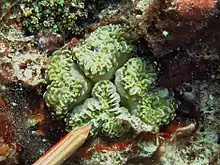Euphyllia cristata
Euphyllia cristata is commonly called grape coral. E. cristata is a kind of stony or hard coral in the family Euphylliidae; it also belongs to the genus Euphyllia in the order of Scleractinia.[2] E. cristata has a wide range of distribution throughout the tropical waters of the Indo-West Pacific area with a large presence in Indonesia.[3] However, despite this large range of distribution, E. cristata has a slightly lower abundance compared to other species, making them a little more uncommon to find.[2][4] They are typically found in shallow waters from 1–35 meters deep.[5][2]
| Euphyllia cristata | |
|---|---|
 | |
| Scientific classification | |
| Domain: | Eukaryota |
| Kingdom: | Animalia |
| Phylum: | Cnidaria |
| Class: | Hexacorallia |
| Order: | Scleractinia |
| Family: | Euphylliidae |
| Genus: | Euphyllia |
| Species: | E. cristata |
| Binomial name | |
| Euphyllia cristata Chevalier, 1971 | |
Taxonomy
Euphyllia cristata was first documented by Chevalier in 1971.[2][3] E. cristata is a Cnidaria of the class Anthozoa and of the order of Scleractinia. Scleractinia are hard corals. E. cristata live in small sized phaceloid colonies, which is a particular type of spatial formation and organisation, where corallites are elongate, distinctive tube-like, and between 20 and 40 millimetres (1.6 in) diameter.[6]
Distribution and Abundance
E. cristata has a wide range of distribution in the Indo-Western Pacific.[7] Their range of distribution also includes the Coral Triangle and the Great Barrier Reef.[3][2][8] Even though E. cristata’s distribution is diverse, it is absent from the Red Sea.[2] E. cristata is found on hard substrates.[7] In addition, they are found in a depth of 1–35 meters below the surface.[7][2]
Threats
The International Union for Conservation Nature and Natural Resources (IUCN) classified the Red List status of the E. cristata as vulnerable in 2008.[2] In addition, many of the other Euphilids have been classified as threatened by the IUCN.[2][5] There are many threats to the populations of E. cristata. As a result of E. cristata being a colorful stony coral with big polyps, it has been sought after for jewelry.[9][10][5][2] E. cristata is also faced with having to adapt to changes in mean tide levels, changes in wave action, increases in water temperature, ocean acidification, fisheries, exposure to pollution, and erosion.[2][4][11][7][10][9][5] These things increase the frequencies of bleaching and increase the susceptibility of the coral to disease.[2]
References
- Turak, E.; Sheppard, C.; Wood, E (2014). "Euphyllia cristata". The IUCN Red List of Threatened Species. IUCN. 2014: e.T133588A54290322. doi:10.2305/IUCN.UK.2014-1.RLTS.T133588A54290322.en.
- Turak, E.; Sheppard, C.; Wood, E. (2008-01-03). "Euphyllia cristata". IUCN. doi:10.2305/iucn.uk.2014-1.rlts.t133588a54290322.en.
- "WoRMS - World Register of Marine Species - Euphyllia cristata Chevalier, 1971". www.marinespecies.org. Retrieved 2020-04-27.
- Best, M.Borel; Hoeksema, B.W.; Moka, W.; Moll, H.; Suharsono; Sutarna, I.Nyoman (April 1989). "Recent Scleractinian coral species collected during the Snellius-II expedition in Eastern Indonesia". Netherlands Journal of Sea Research. 23 (2): 107–115. Bibcode:1989NJSR...23..107B. doi:10.1016/0077-7579(89)90005-7.
- Akmal Khodzori, Mohd Fikri; Saad, Shahbudin; Nordin, Noor Faizul Hadry; Salleh, Muhammad Faris; Rani, Mohd Husaini; Yusof, Muhamad Hamizan; Mohamed Noor, Normahwaty (2015-12-13). "Diversity and Distribution of Euphyllidae Corals in Tioman Island: Emphasis on the Genetic Variation of Euphyllia Cristata". Jurnal Teknologi. 77 (24). doi:10.11113/jt.v77.6694. ISSN 2180-3722.
- "Euphyllia cristata. Corals of the World - Photos, maps and information about corals and reefs". Archived from the original on 2013-10-20. Retrieved 2013-10-19.
- Richards, Zoe T.; Sampey, Alison; Marsh, Loisette (2014). "Kimberley marine biota. Historical data: scleractinian corals". Records of the Western Australian Museum, Supplement. 84 (1): 111. doi:10.18195/issn.0313-122x.84.2014.111-132. ISSN 0313-122X.
- "Euphyllia cristata Chevalier, 1971 - Ocean Biogeographic Information System". obis.org. Retrieved 2020-04-27.
- Jones, Alison M. (2011-08-24). "Raiding the Coral Nurseries?". Diversity. 3 (3): 466–482. doi:10.3390/d3030466. ISSN 1424-2818.
- Tissot, Brian N.; Best, Barbara A.; Borneman, Eric H.; Bruckner, Andrew W.; Cooper, Cara H.; D’Agnes, Heather; Fitzgerald, Timothy P.; Leland, Amanda; Lieberman, Susan; Mathews Amos, Amy; Sumaila, Rashid (2010-11-01). "How U.S. ocean policy and market power can reform the coral reef wildlife trade". Marine Policy. 34 (6): 1385–1388. doi:10.1016/j.marpol.2010.06.002. ISSN 0308-597X.
- Stimson, John (2018-03-01). "Recovery of coral cover in records spanning 44 yr for reefs in Kāne'ohe Bay, Oa'hu, Hawai'i". Coral Reefs. 37 (1): 55–69. Bibcode:2018CorRe..37...55S. doi:10.1007/s00338-017-1633-2. ISSN 1432-0975. S2CID 20233369.
External links
- http://coral.aims.gov.au/factsheets/0146
 Media related to Euphyllia cristata at Wikimedia Commons
Media related to Euphyllia cristata at Wikimedia Commons
